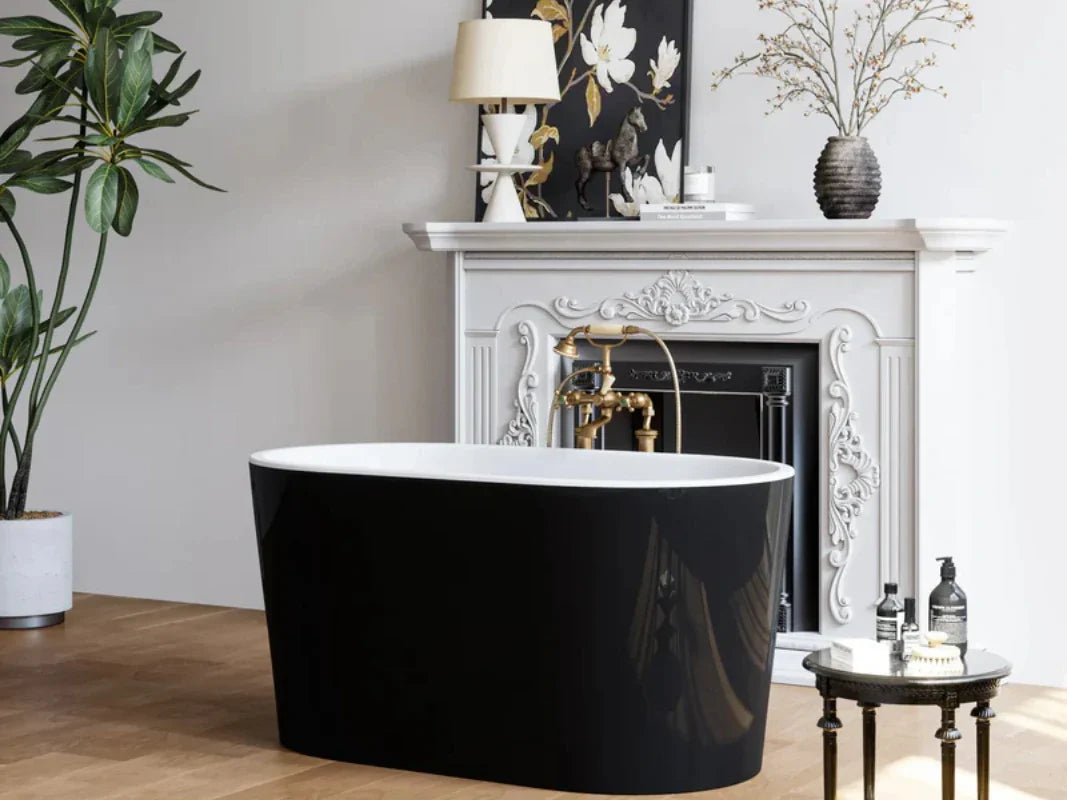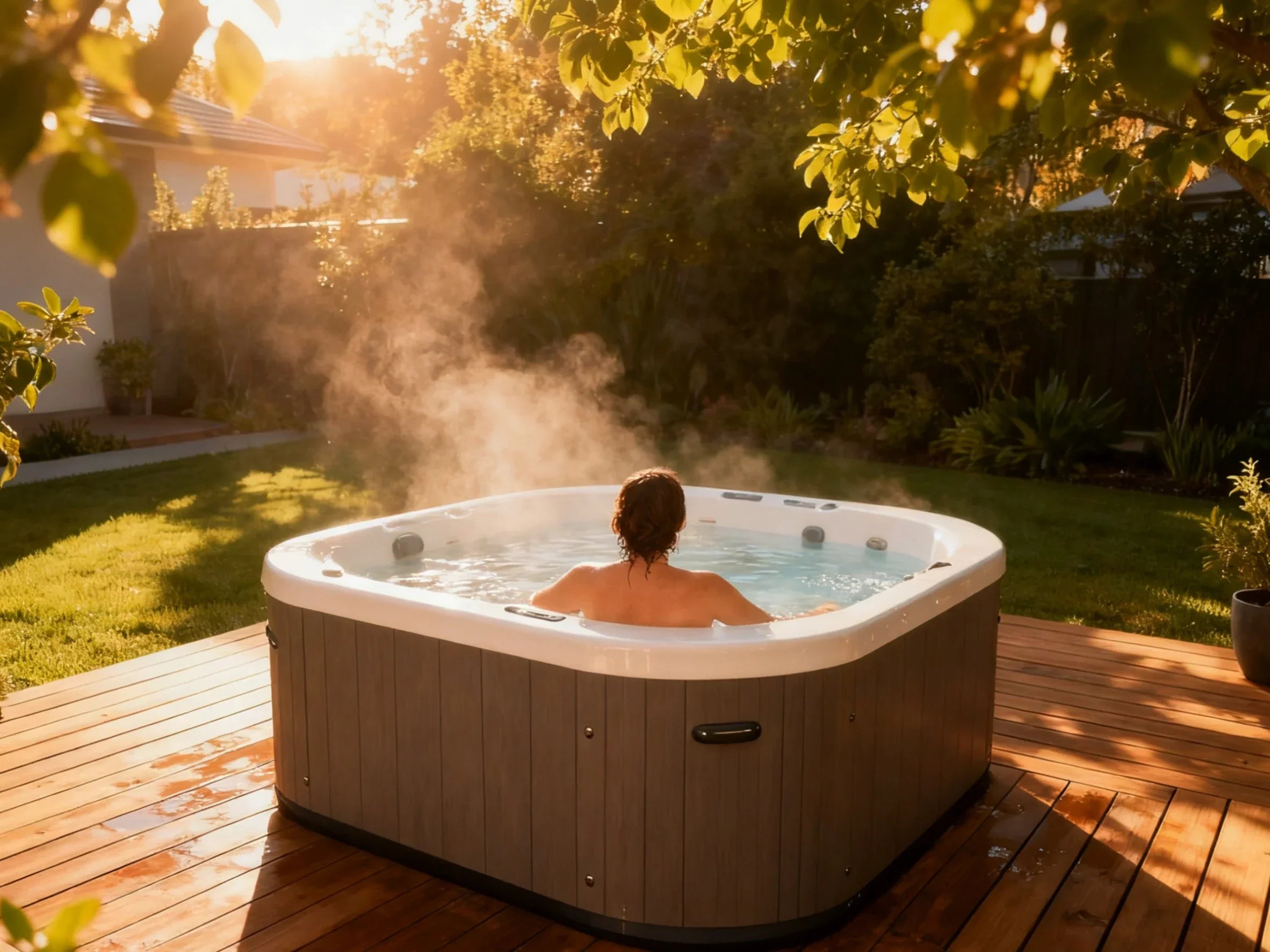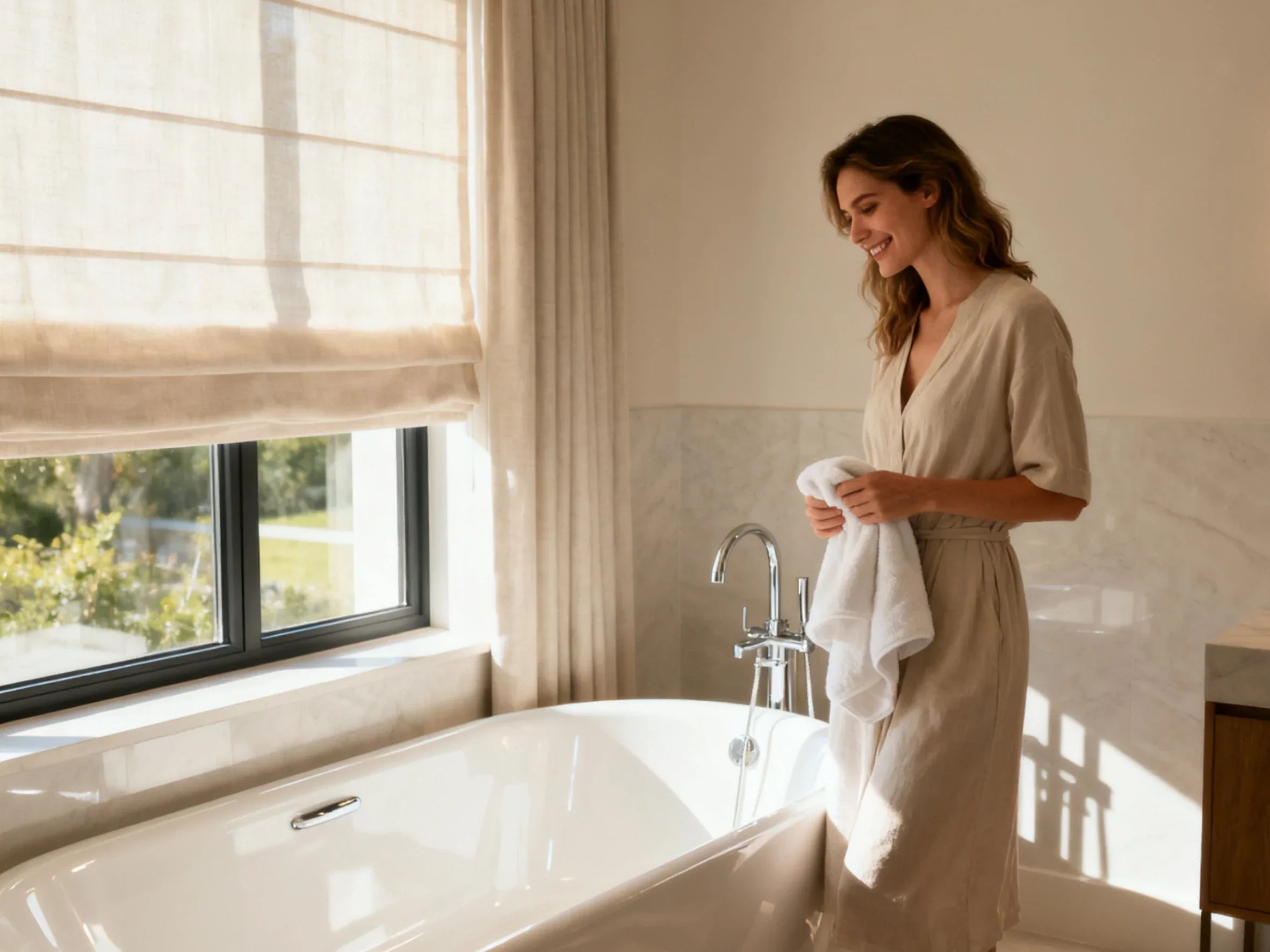Key Takeaways (Read this first)
What it is: Deep-immersion bathtub optimized for small bathrooms; typical size 45–60" L x 27–32" W; 14–22"+ soaking depth.
Why it wins in small spaces: space-saving luxury, faster fill and heat, frequent use, and less water and energy than larger tubs.
Who it’s for: Urban apartments, small homes, primary or guest baths, and anyone seeking at-home wellness.
Materials: Acrylic, solid surface/stone resin, cast iron, copper, wood (ofuro).
Health benefits: Stress and pain relief, better sleep, and mindfulness; research supports warm-water immersion (Source: National Center for Biotechnology Information, 2019).
Quick pick paths:
- Tightest footprint: Japanese-style compact soaking tub (ofuro).
- Best value: Acrylic or stone resin freestanding 48–55".
- Warmth retention: Cast iron or solid surface.
- Statement piece: Copper or sculptural stone.
Watch-outs: Weight and load, doorway clearance, water heater capacity, and ventilation.
Small Soaking Tub Sizing & Fit Guide
Measure once, buy right
- Room mapping: Measure the length, width, and ceiling height of the bathroom, plus the door width and the entire path from entry to the bathroom. Tight halls and stair turns matter.
- Clearances: Leave 2–4 inches around the tub for cleaning and access. Confirm faucet reach, and choose a drain and overflow that match your plumbing.
- User fit: Match soaking depth to torso height. For shoulder-level immersion, target 14–22"+ water depth. If you’re taller, a deeper, upright japanese soaking tub with a seat may be more comfortable than a longer, shallow model.
- Door/path logistics: Confirm hallway and stair widths and any elevator specs if you live in a multi-story building. A narrow-width tub (28–29") often solves doorway limits.
- Weight & structure: Estimate the filled weight. Add the tub’s empty weight + water volume + bather. If you’re unsure about floor capacity, ask a qualified pro. Upper floors often favor lightweight acrylic or composite choices.
- Water weight (lb) = gallons × 8.34
- Gallons ≈ (tub length × width × average water depth in inches × 0.00433)
- Total filled weight ≈ tub weight + water weight + person
- Gallons ≈ 52 × 28 × 18 × 0.00433 ≈ 113 gal (max interior water; real volume is lower after displacement)
- Water weight ≈ 113 × 8.34 ≈ 943 lb
- Total ≈ 95 + 943 + 120 ≈ 1,158 lb Actual water volume will be lower since your body displaces water; this example shows why depth and material matter.

Small Soaking Tub Sizing & Specs: Quick Reference
| Feature | Small Soaking Tub | Standard Tub |
| Space required | 45–60" L × 27–32" W | 60–72" L × 30–36" W |
| Water depth | 14–22"+ | 12–14" |
| Water usage | Moderate (deep but smaller plan) | Higher (larger volume) |
| Install complexity | Moderate (weight varies) | Moderate |
| Use frequency | Often higher (reported) | Often lower |
| Health benefits | Stress, pain, sleep support | Limited by depth |
Layouts that work in small baths
- Alcove retrofit: Convert an old 60" tub-shower into a deep soaking bathtub with an upgraded depth profile. Add a glass panel for shower pairing.
- Freestanding against a wall: A small freestanding soaking tub pulled near a long wall feels airy and keeps cleaning simple.
- Corner install: A rounded corner tub saves inches and opens walking paths.
- Wet-room concept: Use a linear drain, full waterproofing, and a single glass panel for a compact bathroom that feels larger.
- Wall-mount filler above the rim
- Deck-mount on a narrow ledge or integrated shelf
- Slim floor-mount filler tucked near a wall
- Grab bars, textured floors, and a low step-in ofuro with a seat increase safety
- Anti-scald valves protect from temperature spikes
- If mobility is a concern, a smaller footprint tub with built-in seat can be easier to enter and exit

Best Small Soaking Tubs of 2025 (Comparison at a glance)
| Category | Typical L × W × H | Soaking Depth | Material Options | Empty Weight (approx) | Heat Retention | Best For |
| Ultra-compact ofuro (seat) | 45–50" × 27–30" × 28–34" | 18–24" | Acrylic, wood, stone resin | 80–180 lb (acrylic) | High (stone/wood), Medium (acrylic) | Studio bath, deep upright soak, small footprint |
| Compact freestanding | 50–55" × 28–30" × 22–26" | 15–20" | Acrylic, stone resin | 70–220 lb | Medium–High | Guest bath, budget-friendly spa |
| Narrow-width (doorway fit) | 50–60" × 27–28" × 22–26" | 15–19" | Acrylic, composites | 70–160 lb | Medium | Tight doorways, hall turns, older buildings |
| Lightweight upper-floor | 48–60" × 28–30" × 22–26" | 14–18" | Acrylic | 65–120 lb | Medium | Upper floors, faster installs |
| Premium heat-retaining | 50–60" × 28–32" × 22–26" | 16–22" | Solid surface, cast iron, copper | 180–350+ lb | High | Primary spa bath, long soaks |
| Short shower-pairing tub | 54–60" × 30–32" × 20–24" | 14–18" | Acrylic, steel enamel | 70–180 lb | Medium | Tub-shower conversion, family-use |
Brand & Material Deep Dive
Materials, pros/cons, maintenance
- Acrylic: Lightweight, affordable, and easy to install. It heats up fast, and surface scratches can often be polished out. Heat retention is moderate, so consider an in-line heater or warmer bathroom if you take longer soaks.
- Solid surface/stone resin: Dense and smooth with excellent heat retention and a premium feel. These tubs are heavier than acrylic but lighter than cast iron. Maintenance is simple: non-abrasive cleaners and a soft cloth.
- Cast iron: Almost unmatched heat retention and long life. It’s very heavy, so plan delivery and possible floor reinforcement. The enamel is durable, but avoid harsh impacts.
- Copper: Striking and naturally antimicrobial. It keeps heat well, but the surface develops a patina over time. Some people love this warm, living finish. Use gentle cleaners.
- Wood (ofuro): A natural, warm touch and a deep, ritual soak. Wood needs steady care—wipe dry after use, keep room ventilation high, and oil per maker guidance. Great for mindfulness, but plan for humidity control.
What to expect from mainstream makers
- Compact freestanding tubs in the 48–55 inch range with deep soaking profiles
- Narrow-width shells (≤28–29") for delivery through tight paths
- Freestanding deep soaking designs with lumbar support and integrated headrests
- Options for simple chromatherapy, quiet fill valves, and in-line heaters
- Clear weight and fill-volume specs to help with structural planning
Health & Wellness Benefits
- Stress reduction: Warm soaking can calm the nervous system and ease muscle tension. Many people feel a drop in daily stress after a 20-minute soak because heat helps the body relax.
- Better sleep: A warm bath 1–2 hours before bed can help you fall asleep faster and sleep deeper. Research on pre-bed passive heating shows improved sleep quality with water in the 104°F (40°C) range, timed so you cool down gently as you get into bed.
- Pain relief and mobility: Heat increases circulation, which may soothe joint pain and sore muscles after work or workouts. The gentle buoyancy eases pressure on knees, hips, and back.

Small Bathroom Design Strategies
- Space feel: Use light palettes, matte finishes, and large-format tiles to reduce grout lines. This expands the eye and makes a compact bathroom feel open.
- Storage: A floating vanity and recessed wall cabinets keep floors clear. For ofuro installations, use under-bench bins for bath salts and towels.
- Lighting: Layered light works best. Add warm ambient lighting, bright task lighting at the mirror, and soft accent light near the tub on a dimmer for unwinding time.
- Shower pairing: A fixed glass panel or a full wet-room layout keeps the room feeling large. Place the tub filler thoughtfully so it doesn’t crowd your steps.
- Accents: A small potted plant, wood bath tray, or textured stool adds warmth without eating space.
Installation & Budget Planning
Step-by-step roadmap
Plan
- Measure room, doorway, and delivery path
- Pick material and drain/filler type (wall, deck, or floor)
- Confirm floor structure and weight, then order (check lead times)
Rough-in
- Adjust plumbing for drain and valve height
- Match valve and overflow specs
- Add GFCI circuit only if your tub has electric features (e.g., heater, lights)
Set & seal
- Level the tub, confirm overflow seal
- Add flange or silicone per spec; complete waterproofing
- Upgrade ventilation (fan ducted outside) to manage humidity
Finish
- Caulk neatly at edges
- Test fill and drain, check for leaks
- Clean and protect the surface during other finishing work
Timeline
- Simple swap: 1–3 days
- Structural or wet-room conversion: 1–2 weeks
Cost factors
- Tub: depending on material and size. Heavier tubs may have higher delivery fees.
- Labor: Varies by region and scope. Budget extra for reinforcement, tile, or wet-room waterproofing.
- Operating costs: A small bathtub often uses 15–25% less water than large tubs, and the smaller volume heats faster, which can lower energy use. Pair with a matching water heater size for best results (Source: U.S. Department of Energy, 2023).
Real-World Proof: Case Studies & User Feedback
- Urban retrofit: In a compact city bathroom, a couple swapped an old 60" tub for a small freestanding soaking tub about 52" long. They report frequent use, quick fill times, and a calmer vibe with a small soaker tub that fits shoulder-deep immersion.
- Small apartment: A renter replaced a clawfoot with a modern small deep soaking tub and a half-glass shower panel. The tub is easier to clean, and the bathroom feels bigger due to cleaner lines and less clutter.
- Micro-apartment ofuro: A compact japanese soaking tub with an integrated seat turned a 5' × 7' layout into a daily wind-down ritual. Sleep quality improved after consistent evening soaks.
- Accessibility: A senior-friendly installation combined a low step-in tub, two grab bars, and an anti-scald valve, enabling safe, warm soaks to ease joint pain—without enlarging the room.
Potential Drawbacks & How to Solve Them
- More water than a quick shower: Choose a tub with a smaller footprint and good insulation. Use a thermostatic valve to avoid overfilling while chasing temperature.
- Weight and install complexity: If you’re on an upper floor, favor acrylic or lighter composites. For heavy materials like cast iron, plan for pro install and potential reinforcement.
- Cost: Want value? Go with acrylic or stone resin. Put your budget into depth and ergonomics rather than extra length.
- Limited room to stretch: Pick deeper, upright shapes with lumbar support. An ofuro with a seat gives a full-body soak even if your legs aren’t stretched out.

How to Choose: Factors Compared
What you’ll actually feel
- Upright ofuro: A deep tub with a seat. You sit high, shoulders covered, knees bent. It’s ideal for small rooms and long soaks.
- Compact freestanding: Clean lines and a light feel in the room. Works great alongside a wall or in a corner to free up bathroom floor space.
- Short soaking alcove tub: Fits a tub-shower conversion. Adds soaking depth but keeps shower function for guests and kids.
- Portable soaking tub for adults: A foldable option for renters or tight budgets. It won’t have the same permanence or insulation, but it can offer warm soaks without major plumbing changes.
Picking by goal
- Want the deepest soak in the smallest footprint? Choose a japanese soaking tub with a seat.
- Want a balanced, budget-friendly option? Pick a 50–55 inch acrylic freestanding tub with 16–18" depth.
- Want longer heat retention? Go with solid surface or cast iron (plan for weight).
- Want an easy delivery path? Pick a ≤28–29 inch width and check stair/turn widths.
Water Heater and Ventilation
- A mixing valve set to a safe max temperature
- Filling more slowly to allow heater recovery
- Staggering other hot water use in the home
Tools & Downloads
- “Will it fit?” calculator (manual steps you can do now)
- Inputs: Room L × W × H; doorway width and height; path turns; user height and shoulder height; tub candidate L × W × exterior height.
- Outputs: Fit check (yes/no), depth target based on torso height, and weight estimate:
- Weight estimate = tub weight + (L × W × depth × 0.00433 × 8.34) + person weight
- Buyer’s checklist (print or note app)
- Space measurements, delivery path photos, plumbing rough-in heights, valve/overflow specs, fan CFM, water heater size, and any permits.
- Comparison sheet template (shortlist 3–5 models)
- Columns: L × W × H, soaking depth, material, empty weight, estimated filled weight, valve type, overflow style, price band, and “best for” (studio, guest, primary spa, accessibility).









Leave a comment
This site is protected by hCaptcha and the hCaptcha Privacy Policy and Terms of Service apply.